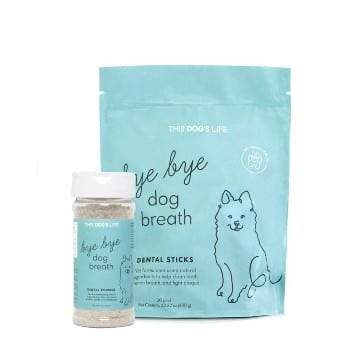Most dogs love getting their teeth cleaned! I’m kidding, of course. For many puppy parents, brushing their dog’s teeth can be a major hassle. And that’s a problem because the health of your dog’s mouth has a lot to do with the health of his whole body. A bad case of dental disease can leech bacterial throughout the system, turning an otherwise healthy pup into a very sick dog.
The best way to care for your dog’s teeth is by regular brushing. It’s best to start your pooch on a toothbrush when he’s still a puppy, and even then, he may need a little convincing. But any age dog with a little patience and a lot of treats can learn to tolerate a tooth brushing.
If you haven’t ever brushed your dog’s teeth, starting with a professional cleaning by your veterinarian is recommended. It’s done under anesthesia and can be quite expensive, but it’s necessary. But how often and when do you start?
Related: A Vet Answered All Our Questions About Dental Disease, the No. 1 Health Issue In Dogs
That depends on the breed and the condition of his teeth. Some smaller breeds like Yorkies, Pugs, Chihuahuas, Maltese, Chinese Crested, Cavalier King Charles Spaniels, Toy Poodles, and Dachshunds, and some larger breeds like Greyhounds and Shelties, are NOT genetically blessed when it comes to dental health. These breeds will need a dental cleaning as early as 2 years old while other breeds can often wait until they’re 5 or 6
Before and in-between professional cleanings, brushing your dog’s teeth is the best way to keep his chompers pearly white. (If your dog despises the toothbrush, there are other alternatives.)
When you first start getting your dog used to a toothbrush, go slow. Even after he’s accustomed to the brush, start by brushing his teeth once a week.
Get a FREE guide that teaches you EVERYTHING about brushing your dog’s teeth
Here are a few points to get you started.
Get the right toothbrush and toothpaste for your dog.
There are toothbrushes made for dogs that come with two different sized brush heads, finger toothbrushes, brushes for large breed dogs, small breed dogs, and dental packages that come with different brushes and doggie toothpaste. Only use a toothpaste made for dogs, which comes in a variety of flavors, or a recipe for a dog-friendly toothpaste that you can make yourself. Do not use human toothpaste.
Related: Special Offer on our Bye, Bye Dog Breath Dental Kit
Start slowly.
Begin by introducing your dog to the toothpaste. Put some on your finger, and let him lick it off. Do this for a few days in a row, and follow it by lots of treats. Next, put some toothpaste on your dog’s front canine teeth. This will help him accept something touching his mouth and his teeth. Also do this for a few days and use treats and praise.
Get your approach down.
To introduce your dog to the brush, don’t stand over him, which can make your pooch feel afraid or threatened. Approach him by sitting behind him, at his side or kneeling in front of him. Put some toothpaste on the brush, and let him lick it off. It will allow him to get used to the brush’s texture and having an object near his mouth. Practice for several days using treats and rewards.
Related: 7 Natural Ways to Stop Bad Dog Breath
Be patient.
Finally, it’s time to actually try brushing your dog’s teeth. Lift his lip to expose the teeth. Hold the brush at a 45-degree angle against the teeth, and slowly — and gently — brush the outside of the teeth. Make sure to reach the back upper molars and canines as those tend to collect a lot of tartar. When you’re done, reward your dog enthusiastically, but this time, use a non-food reward like playing, petting, or any activity that your dog loves.
Go beyond the toothbrush.
Ideally, daily brushing is recommended. Of course, that’s not always possible (life tends to get in the way). In-between frequent brushing, there is This Dog’s Life Bye, Bye Dog Breath Dental Kit, which makes cleaning your dog’s teeth a cinch. There is a dental powder that you just sprinkle on your dog’s food and dental sticks you give as treats during the day. Both help keep teeth clean, free of plaque, support gums and freshen breath.
There are also dental wipes to remove food and bacteria and freshen the breath, along with a variety of dental dog treats, dental sprays (get one that is alcohol-free) and dog chews that work to remove food from the teeth.
So, there are no excuses for your dog to live a long and happy life!














